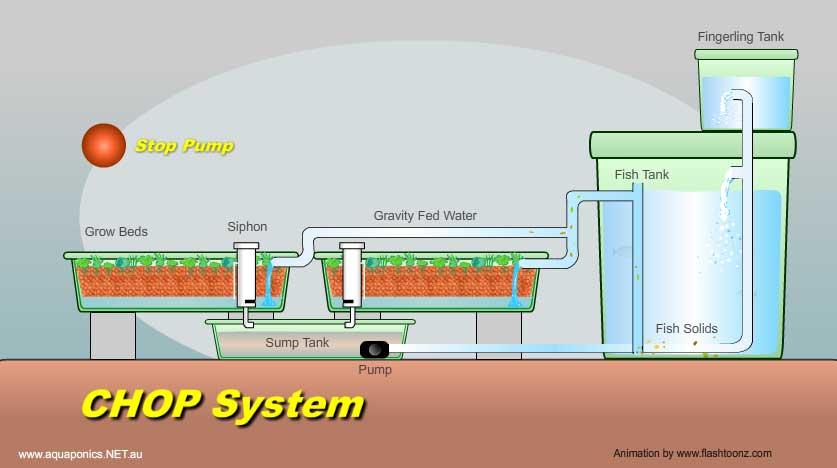How an Aquaponics System Works: Animation

Here at Ecofilms we’re big fans of Aquaponics. We think its so good that we run a system outside our office that was designed and built by Murray Hallam an Aquaponics pioneer here in Australia. But how does it actually all work? Many people have problems trying to get their heads around the plumbing and technical aspects of fish and vegetable grow beds. They say its too complicated and too technical to build a system themselves. So we asked Murray to explain in detail how it works. We created this flash animation that was used in Murray’s DVDs and are sharing this knowledge here and explain some of the secrets behind the auto-siphon and why flood and drain is the way to go for the backyard hobbyist. The home DIY hobbyist could build these systems if they understand two things. How the AutoSiphon works and the general layout of an Aquaponics System.
The Auto Siphon or Bell Siphon
If the pump is the heart of an aquaponics system, then the auto-siphon are it’s lungs. A vital part of kit. Remember when you were a little kid and the teacher told you about the regular flooding of the Nile river and how fertile the Nile delta was to early farmers. Well think of the auto siphon as a kind of similar concept. It’s main purpose is to flood the grow bed drawing rich oxygen into the depths of the trough, oxygenating the plant roots and turbo charging the bacteria to do their thing.
Click on the Red Button below in the Flash animation to start the system. Click the button again to end the animation.
[swfobj src=”http://www.ecofilms.com.au/wp-content/uploads/2010/06/Siphon.swf” alt=”The Auto Siphon” width=”600″ height=”350″]
The flood and drain cycle is powered by a small pump either located in a sump or in the fish tank itself. The pump can run by a timer or be permanently on. The drain cycle varies depending how large your trough is and how fast the water is pumping back into your grow bed. The one we have here at home flood and drains on average every 14 minutes. A smaller grow bed will drain faster. It doesn’t matter how long it takes as long as the plant roots are well oxygenated. The bacteria are living organisms that process the fish waste through mineralization of the solids into nutrients that the plant roots can readily absorb. Thats why aquaponics works so well. It mimics a living eco system. No chemicals are used. No pesticides are used. Your cost is only your plant seedling, some fish and your power bill to run the pump. Our system costs us $100 a year to run and works brilliantly. In fact it just gets better with age.
So how do you build a auto-siphon? Are there any moving parts? No none at all. The trick of the siphon is to create an imbalance in air pressure that forces the water to drain rapidly. There is a fine little plastic tube that is an important ingredient to the siphon. Its role is to break the suction immediately so the grow trough can fill again with water. Many problems with auto siphons can be traced back to the break air tube not activating properly causing water to endlessly dribble back to the fish tank. Having too much or too little water pumping into the grow bed can also create problems of flows. When the siphon is in balance, the system will run for months without adjustment.
The CHOP System
The animation below is a CHOP system. It stands for Constant Height One Pump. The term was coined by Murray Hallam although other aquaponicists may know it as CHIFT-PIST which sounds like something you do in a public urinal! That term also means Constant Height in Fish Tank. Pump in Sump Tank. So much for the terminology. What does it all mean?
[swfobj src=”http://www.ecofilms.com.au/wp-content/uploads/2010/06/Chops.swf” alt=”Press Red Button to play animation” width=”600″ height=”350″ align=”center” allowfullscreen=”true”]
In early aquaponics systems the pump was located in the main fish tank. This would work quite well. However a constant draw of water from the main fish tank to the grow beds resulted in the water level in the fish tank rising and falling to the ebb and flow of the siphons. If there was ever a problem with the pipes such a connection hose leaking then the pump could drain all the water out of the fish tank resulting in dead fish.
In the CHOP system however the pump is located in a separate sump. If the pump malfunctions or any pipe fittings break, there will always be water in the fish tank keeping your fish alive. The water from the main fish tank falls to the grow beds below by gravity. Water must find its own level. It can’t flow uphill. But it can flow downhill. So the water level in the fish tank will always stay perfectly level. Only the water returning back to the tank from the sump will cause a fresh load of water to fall by gravity back to the grow bed and sump. So the system repeats in an endless cycle. Notice the pipe drawing water from the bottom of the main fish tank? Any fish solids are drawn from the base of the tank and deposited into the main grow beds as fertilizer for compost worms that help the system thrive. The whole system is powered by just one small electric pump. A 4500 litre per hour pond pump. Additional grow beds can be added to make the system even more elegant and productive.
More details about Aquaponics is discussed in the Aquaponics Secrets DVD that goes into a lot more depth and detail than can be mentioned on this page.







Awesome animations Frank. By far the best explanations of aquaponics i’ve ever seen.
I’m going to show them to my PDC classes this weekend.
Thanks Nick. Hopefully see you at the Permaculture convergence in Cairns in September.
great, simple to understand view on how CHOP works. will convert mine this weekend based on your animation. how about an animation on The “Aquaponics Sequencing Valve” ?
muy buen sistema frank pero yo no entiendo para que es el fingerling tank ,¿ cual es su funcion?,
uqe tiene dentro ??
(frank very good system but I do not understand what is the fingerling tank, what is its function?)
Hi Axel, the fingerling tank is just an optional accessory. Its not necessary to the overall success of your system. The animation was based on a Murray Hallam designed aquaponics system that also had a fingerling tank so that people could have an endless supply of fish to grow and eat. You will appreciate a fingerling tank when you suddenly realize that most of your big fish are eaten and now you want to introduce more baby fish into the tank. Larger fish can eat your smaller fish unless they are separated.
I am currently doing aquaponics as my science fair project and I took a freshwater test, and the Nitrite was at the danger level. I think this caused one of my black pop eyed goldfish to die. The fish was covered in this white, fluffy stuff. Almost like it was covered in spider webs. We also had an old log (like a decoration) and the white fluffy stuff was growing on it too. So we drained out all the water from the tank and placed all the remaining fish in another tank. My dad thinks this happened because we didn’t have enough plants in the growing bed and we didn’t know that we had to clean the filter out every week (this is our first time ever having a working aqaurium). Tomorrow we are going to fill the tank with new clean freshwater and transport the entire tank and other materials to school. All the plants are growing perfectly so that’s not a worry. Please respond and say anything that could help me in any way with the project.
Sounds like a fish fungus to me Macy. Stressed fish that lose their slime coating can attract certain nasty bacteria and fungal diseases to grow on their bodies. Keep your fish healthy by supplying them with lots of aeration and sparkling clean water that is circulating around the system. A healthy system will make your fish less disease prone, stronger and able to resist any disease that’s in the tank. They will also be a lot happier.
are there anykind of nuturients I can add to system that won’t harm the fish? My fish are small and not producingenough at this time. Thanks
Hi Dennis, try a splash of Maxicrop if you are living in the US or Seasol if in Australia. This is a seaweed extract with lots of nutrients for plant growth. We add worm-juice as well which contains lots of goodies.
http://www.ecofilms.com.au/2010/09/20/adding-worm-juice-to-aquaponics/
Here are some instructions on making your own worm farm:
http://www.ecofilms.com.au/2010/08/08/building-a-worm-farm-in-a-bathtub/
All these things will kick the plants along until your fish are producing enough nutrients. Good Luck!
Hi Frank
Thanks for the practical animations. Quick question – I understand the water flows from the fish tank to the growbed with gravity as the water level in the fish tank rises – like an overflow system. Are the fish solids pumped from the bottom of the fish tank out to the growbed?
Thanks
Regards
Nikki
Yes Nikki, the solids dissolve in the water as effluent. The pump cleans the water through the gravel media and is returned to the fish tank for the whole cycle to start again.